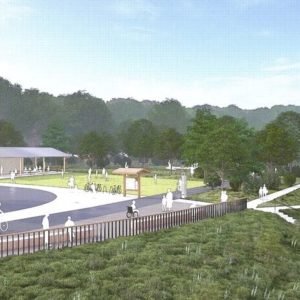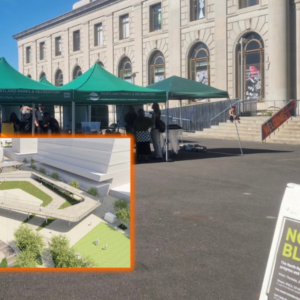
The Portland Bureau of Transportation is putting finishing touches on their North Portland In Motion (NPIM) plan and they’ve just released the final online open house.
NPIM aims to improve the future of biking, walking, and transit on Portland’s peninsula from I-5 between the Overlook and Kenton neighborhoods, west to Pier Park in St. Johns. It launched in 2021 and will likely be adopted by City Council in early 2024. These planning processes (similar ones have been done for east and southwest Portland) are important because they result in a prioritized, clearly-defined list of projects that are shovel-ready and primed for funding. In some cases, the process validates current PBOT planning and they’re able fund and build the projects before the plan is adopted by Council.
These “In Motion” plans have been popular with both PBOT and Portlanders because they add transparency and predictability to the planning process. They also take a network-level view of what needs to be done to make the system (not just one location) safe, which makes each project easier to justify in the case of pushback (as in, “I hear you, but this is part of North Portland in Motion, which went through a comprehensive outreach process and was adopted by City Council, so we’re going to do it even if you don’t like it.”)
As we’ve shared in previous NPIM updates, PBOT gathered community feedback and categorized projects in three different types of projects: neighborhood greenways, corridor improvements, and “plazas & places to connect.” Each set of projects is then prioritized into tier 1 or tier 2.
This week PBOT released detailed, updated project overviews and drawings for seven greenway projects and nine corridor projects. You should definitely check the online open house and click through each one. And/or you can check a few highlights below:
Neighborhood Greenway projects
Circulation changes at St. Johns Bridgehead: This project would prohibit and divert some traffic on bridge frontage roads in an effort to drastically reduce cut-through traffic. This would have a major impact on bicycling since so many people use these roads to get on and off the bridge.
New greenway on N. Burr: This project would create a north-south connection from Willamette Blvd (at Cathedral Coffee) all the way to George Middle School on Columbia Blvd.
Kenton Park: As part of an extension of the greenway network, PBOT wants to expand the existing median island at the junction of N Kilpatrick/Halleck streets and N Delaware Ave and prohibit drivers on the slip lane at the southwest corner of the park.


Strengthen N Ainsworth greenway: Already a very popular bike route, PBOT knows there are way too many drivers on Ainsworth between Vancouver and Willamette. They’re considering two diversion plans to force drivers off Ainsworth and onto larger streets like Rosa Parks Way and Killingsworth. The first option would extend the parkway on N Omaha across Ainsworth and create a new culdesac that allows only non-drivers to pass through. The other option would create alternative one-ways for drivers on Ainsworth, but maintain bi-directional bike lanes.
Near-Term Corridor Improvement Projects
Bike access to Cathedral Park: PBOT wants to make it easier to access this popular park from Willamette by striping 9-foot wide buffered bike lanes on the uphill directions of N Richmond and Baltimore and eventually make bike-friendly changes to N Crawford where it goes through the park near the Willamette River.
Protected bike lanes on N Willamette: PBOT has a major, federally-funded plan for protected bike lanes on Willamette from Rosa Parks to Richmond. But since it won’t be done until 2026, they want to get bike lanes on the ground next year where they don’t exist today between N Ida (Fred Meyer turnoff) and Richmond. The lanes would be 8-feet wide (five for riding and a three-foot buffer) and would take the place of existing on-street car parking.
Safer Fessenden: PBOT wants to neck down the wide intersection at N Fessenden and Wall and reduce the crossing distance by 75%. This safer design would calm traffic and make it much safer to access the nearby Peninsula Crossing Trail.
New bike lanes on N Alberta over I-5!: From PBOT: “This project will redesign the layout of N Alberta St to provide a separated, comfortable bike lane connection between N Interstate Ave and the N Michigan Ave Neighborhood Greenway. Furthermore, this project would add bike boxes and no-turn-on-red at the signalized intersection at N Interstate Ave to reduce conflicts and improve pedestrian and bike safety.” Boom! Yes!
These are just a sampling of the intriguing projects that are part of NPIM. Please visit the online open house and let PBOT know your feedback. They are accepting comments through January 31st.













Thanks for reading.
BikePortland has served this community with independent community journalism since 2005. We rely on subscriptions from readers like you to survive. Your financial support is vital in keeping this valuable resource alive and well.
Please subscribe today to strengthen and expand our work.
The Alberta St over I-5 improvements have been a long time coming, this is my preferred route to take to link up with Willamette Blvd (ride through the park by the old fire station) and onto the bluffs and St Johns. That segment is by far the worst. Heck yeah!
This is probably my favorite project, too. There are no bike lane connections across I-5 between Skidmore and Killingsworth, which is a pretty long gap, and the Killingsworth bike lanes are pretty narrow. I use Alberta a lot to transition across I-5 but it’s always stressful and this would make it so much better.
I’m sure it’s a typo but the idea of PBOT rolling out a new project and touting tiny little painted bike lanes has me in stiches.
JM was listening to Nine-Inch Nails when writing this piece.
Excited about these. Hopefully PBOT will move forward with them
Read through this today and found myself really excited by all the good stuff in there. N Willamette is the star of the show for me, but I was pleasantly surprised to see a ton of smaller wins for safety and livability as well.
One thing I liked about the EPIM was it’s emphasis on connecting residents to nearby employment, including the airport, Clackamas Town Center, Gresham, and even downtown. I find the maps for NPIM disconcerting – is North Portland simply a bedroom community? Why no connections to Swan Island, Downtown, west of the Willamette, and the port facilities in the north? The whole thing looks so insular that I’m utterly underwhelmed.
In Portland and most other jurisdictions, the amount and rate of infrastructure funding is tied directly to how much a mode has an impact on trips to work, as measured by the census (both the big one every ten years and in between through the American Community Survey). The emphasis is on work trips, not recreation.
When the BMP 2030 was completed in 2010 and the EPIM soon afterwards in 2012, the city was still trying hard to increase bicycle (and walking) mode share for trips to work – in PBOT’s planning literature and outreach, the focus was on trips to work. Contrast that with this document, it’s language, and how it is being promoted, and you realize that not only has PBOT completely given up on increasing bike mode share for work trips, but even many advocates have given up as well – BP now touts all the cool routes of the NPIM, coming weekend recreational bike events, Pedalpalooza in June, numerous articles on how to make bicycling fun and enjoyable.
Most of the USA is car-work-focused, we all know that, we who advocate for bike improvements battle that constantly. But even in Portland bicycling is no longer viewed as a preferred mode of choice to get to work, but it is now viewed by most BP readers as primarily for recreation. Even the controversies over NE 33rd and on Broadway were focused on how it was ruining the safety of recreational riders – those whose comments were focused on how the changes would affect their work commutes were hardly upvoted at all – and so even the BP readership has shifted towards a recreation-cycling focus and away from transportation-cycling.
And so PBOT, like it or not, is reflecting this attitude change, as is JM in his write up on the plan:
Nothing about connecting to jobs, other parts of the city, increasing mode share.
Here’s a map of regional job density from TriMet’s Forward Together plan:
Note the thick job corridor in Beaverton, Tigard, Hillsboro. Other Portland job centers hug the river. It makes for a transportation cunundrum, much regional employment is on the other side of a small mountain range, known affectionately as West Hills. The flatter parts of the mid-eastside area are easy to bike/provide transit lines for, but they are largely residential, with few jobs.
There are other relevant maps in this BP post (transit access, poverty density): https://bikeportland.org/2022/10/06/moving-forward-into-the-forest-with-trimets-new-service-concept-364900
Lisa, thank you for the map and link.
So here’s a thought exercise: Apparently Oregon thinks it can fund a new bridge over the Columbia for $7 billion over 30 years of bond payments. If Washington state picked up half the tab, then Oregon will pay $3.5 billion over 30 years, or $116 million annually. So let’s say the project gets cancelled – How would you spend $116 million annually in new transportation money that isn’t already committed for anything, for say the next 4 years, about $464 million total?
That’s about six Blumenauer bridges per year, more if you don’t require them to support emergency vehicles. Or, it’s about 32 miles of Moody bikeway, 2-way plus a separate pedestrian sidewalk and landscaping, based on a PBOT estimate that they can build it for $700/foot. That’s about enough to cross Portland twice, every year. I’d guess that if we were building on that scale the construction cost could be whittled down a bit.
Is that $116 million the yearly bond payment, or do we need to add on interest?
It assumes you’ve already taken out the bonds and committed to paying them off for the next 30 years, likely with future state gas taxes and vehicle registration fees. As others will likely point out, it also implies that Oregonians will continue to buy and drive gasoline-powered cars for the next 30 years, or find some alternative way to fund highways.
Ok, but does the $3.5 billion include interest payments, or is the interest added to that?
This map shows what an important job center Swan Island is- I think it is insane they left it off this plan. They also cut off North Portland on the west side of I-5 even though North Portland extends to MLK. This may explain why the proposed bike lanes on Alberta only go to Michigan instead of making a connection to 7th or at least Vancouver (they made the same error with Skidmore).
Anything that promotes connectivity of the network lends itself to bike commuting. Unfortunately for raw statistics a lot of former bike commuters now go to work most days in their slippers. I actually support the sort of local improvements listed here because they help prevent the type of banal traffic violence that can kill kids going to school or people who just need a loaf of bread or something. Maybe Portland is making a little progress on this sort of thing. It’s relatively easy because it can be done on existing right-of-way and often has local support. People know about the kid or the parent that died and the feelings are raw for a long time.
I would love to see Portland take on visionary long distance bike route projects that connect residential areas to concentration of jobs, or regional shopping areas, or yes, recreational destinations. Portland, and Oregon, are leaving money on the table as a travel destination. Many of the travellers are already here but they’re stymied by the inconvenience or even danger of reaching the places they would like spend their time and, yes, money. That money translates to jobs and it stays in the state. The governor is touting the I-5 expansion as a jobs program but the gain is short term and where does the money go?
Could you see a future Portland where an overwhelming majority of the human workers in the Swan Island industrial district (and surrounding high-employment areas) bicycle or walk to work from nearby neighborhoods? If so, what would the network look like?
I think there’s a valid concern around the lack of connection off-peninsula (esp to central city) and do wish this plan did more to address that.
That said, why are work trips the only trips that matter? There are more categories of travel than just “work” and “fun”.
People get in cars to take kids to school and activities, and safer local routes make it easier for kids to make those trips independently.
People get in cars to go shopping, pick up food, and even to go to recreational destinations.
I’ve biked to work zero times in the last year, but I replace about 3 car trips a week with bike trips. That’s still pretty meaningful, isn’t it?
The vast majority of all trips are “non-work” trips that are more likely to be shorter and in bikable distance, so if we actually want to move the needle on mode shift it makes sense to focus on trips to schools, shops, parks, etc. Work only accounts for two trips a day at most, and nowadays often only two or three days a week with hybrid work, and more and more people work from home full-time. And people may not realize it, but the majority of people don’t have a job. Retired people, stay at home parents, kids and teenagers, unemployed people, people on disability…they add up to way more than the prime-age working population. The obsession with work trips in transportation planning was always more about “reducing congestion” (i.e. trying to make it easier to drive) than anything else.
You are partly right. Transportation planning agencies employ people who build models of people’s behavior. Those models are filled with hypothetical people largely based on aggregated data of where people live and work based on the W4s all “legitimate” workers file (and get a W2 in return). Retirees, the unemployed, those folks who work in a cash-only economy (the gray economy), criminals of various sorts, most children, folks on disability, as you say, aren’t part of this economy. These transportation modelers then use census data (which theoretically captures everyone) to try to modify the models to better reflect actual travel behavior – trips shopping, visit friends, school, and so on. It’s imperfect, we all know that, but a lot of transportation funding and decision-making is tested by these models. And so your daily bike trip from your home to your workplace, assuming you’ve filed a W-4, is the only set of trips we can reliably capture.
Thanks DH for calling out the lack of connections to N. Portland industrial/employment areas…Swan Island and Rivergate. (Note that job density in the latter is higher than Lisa’s map due to the large areas of open space there.)
I noticed the lack of any attention to this planning effort when it was initiated and was informed that PBOT defers to the Port of Portland for transportation infrastructure in both areas.
The North Portland Greenway Trail will provide important connections in the not too distant future via the Columbia Blvd Bridge project. Readers need to press Portland Parks and Metro to fully fund that project.
Swan Island saw several improved connections during my days at the Swan Island TMA…Waud Bluff Trail and bridge opened, and the Going Street sidewalk was widened. When I left the scene, Daimler employees trailed only OHSU and Nike in the number of bike commuters. Many of those hardy souls knew of and regularly used the Ash Grove Cement Road…another important piece of the NP Greenway.
Will there be enough money to fund these projects given the budget crisis at PBOT? Given the tax fatigue of Portland residents will the Portland gas tax be extended? In my opinion if the poorly planned, poorly executed and ineffective taxes (PCEF, Homeless, Arts Tax, Preschool Tax) aren’t eliminated or modified significantly, the funding of basic, essential municipal services and transportation projects in Portland will be in jeopardy for decades to come. It’s time to let voters decide where they want their money to go. I think many have changed their mind about their past votes and would prefer to fund essential services and transportation infrastructure. I certainly have and so have many of my friends and neighbors.